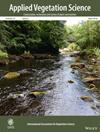Systematic reduction in seed rain of large-seeded and endozoochorous species in pastures compared to forests along a tropical elevational gradient
Abstract
Questions
How do seed rain biomass and richness change from old-growth tropical forests to pastures at different elevations? How do seed mass and seed dispersal mode change from forests to pastures across these elevations? What implications do these changes have for the recovery of deforested areas in tropical mountains?
Location
Old-growth montane forests and livestock pastures along an elevational gradient (1,000–3,000 m a.s.l.), located at Podocarpus National Park, San Francisco Reserve and surrounding agricultural lands, Andes of southern Ecuador.
Methods
We collected seed rain for a 3-month period using 324 traps installed at eighteen 1-ha plots across elevations. Half of the traps were installed in nine 1-ha forest plots, and the other half in nine 1-ha pasture plots. For each trap, we identified the seeds and measured seed rain biomass and richness. We also recorded seed traits and calculated community-weighted means of seed mass and seed dispersal mode (proportion of endozoochory).
Results
Forests received a higher seed rain biomass than pastures, but only at the lowest elevation. Seed rain richness did not differ between habitat types at all elevations. Community-weighted means of seed mass and the proportion of endozoochorous species declined from forests to pastures, especially at the lower elevations.
Conclusions
Although seed rain biomass and richness were overall similar between forests and pastures, large-seeded and endozoochorous species were generally poorly represented in the seed rain of pastures compared with that of forests. These findings show that biomass and richness of seed rain may be insufficient to quantify the restoration potential of natural seed rain in deforested areas. Information on seed traits, such as seed mass and seed dispersal mode, is important to optimize restoration efforts towards the regeneration of diverse old-growth forests along elevational gradients in tropical mountains.


 求助内容:
求助内容: 应助结果提醒方式:
应助结果提醒方式:


